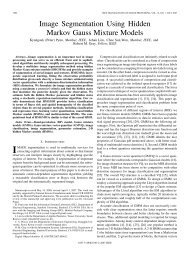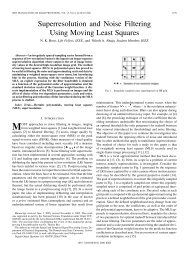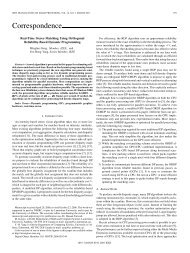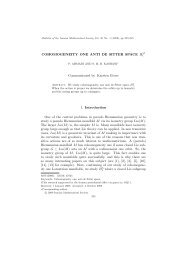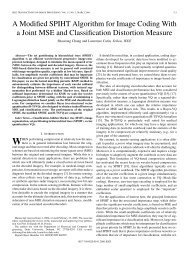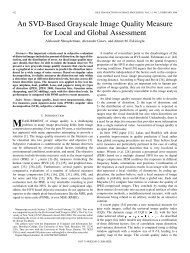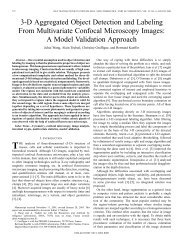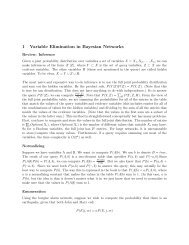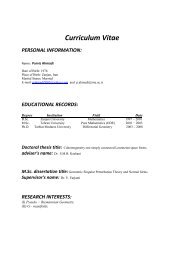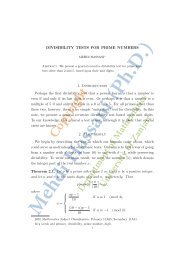Optimization of phase-only computer-generated holograms using
Optimization of phase-only computer-generated holograms using
Optimization of phase-only computer-generated holograms using
You also want an ePaper? Increase the reach of your titles
YUMPU automatically turns print PDFs into web optimized ePapers that Google loves.
0<br />
4-<br />
-C<br />
U)<br />
6)<br />
0<br />
-C<br />
0<br />
63<br />
><br />
6)<br />
Position x<br />
Fig. 6 Phase pr<strong>of</strong>ile <strong>of</strong> the wavefront through an aperture.<br />
Figure 6 shows an example <strong>of</strong> a <strong>phase</strong> pr<strong>of</strong>ile. A high<br />
index difference (aperture center area) gives a large <strong>phase</strong><br />
shift. Because <strong>of</strong> the diffusion that takes place in all directions,<br />
there is also a <strong>phase</strong> shift outside the aperture region.<br />
This causes <strong>only</strong> small reductions in diffraction efficiency,<br />
but is a major problem when making aperture <strong>holograms</strong>.<br />
Fourier transforming the <strong>phase</strong> pr<strong>of</strong>ile <strong>of</strong> Fig. 6 gives the<br />
diffraction pattern, and therefore also the diffraction effi-<br />
0.40<br />
0.35<br />
> 0.30<br />
6)<br />
0.25<br />
4-<br />
4- 0.20<br />
Li<br />
0.15<br />
L<br />
4-<br />
4- 0.10<br />
6)<br />
0.05<br />
0.00<br />
0.40<br />
0.35<br />
8.30<br />
0.25<br />
4-<br />
4. 0.20<br />
Li<br />
0.15<br />
0 8 16 24 32 40 48 56 64 72 80 88 96 104112120128136<br />
Pos I t I on<br />
1262 / OPTICAL ENGINEERING / June 1992 / Vol. 31 No. 6<br />
(a)<br />
C4<br />
4- 0.10<br />
8.05<br />
I I I I I Ji L I I I I<br />
a a 18 24 32 40 48 56 84 72 80 88 96 104112120128136<br />
Pos I t I on<br />
(c)<br />
BOLSTAD, YATAGAI, and SEKI<br />
Fig. 7 Calculated diffraction patterns: (a) 0=182.1<br />
(d) 0=240.3 deg.<br />
ciency, as shown in Fig. 7. In this figure we can see the<br />
result for four different <strong>phase</strong> pr<strong>of</strong>iles. It is drawn with the<br />
maximum <strong>phase</strong> shift as a variable. We can see that at near<br />
180 deg, there is still a considerable energy left in the zeroorder<br />
(30%), whereas there is about 35% in the first orders.<br />
Increasing the <strong>phase</strong> shift to about 220 deg gave the best<br />
result for this particular pr<strong>of</strong>ile with 13% left in the zero<br />
order and about 37% in the first orders, compared to the<br />
theoretical limit <strong>of</strong> 40% for a binary <strong>phase</strong>-<strong>only</strong> grating.<br />
Other pr<strong>of</strong>iles had even higher efficiencies. Figure 8 shows<br />
the best result with maximum <strong>of</strong> 38.5% in the first orders<br />
at 210-deg <strong>phase</strong> shift, which is very close to theoretical<br />
prediction <strong>of</strong> 0 — 220 deg. A corresponding low diffraction<br />
efficiency <strong>of</strong> 5% is obtained at 250 deg for the zero order.<br />
Because <strong>of</strong> the broadening <strong>of</strong> the <strong>phase</strong> pr<strong>of</strong>ile in the ion<br />
exchange there is a shift in the efficiency curve to a somewhat<br />
higher <strong>phase</strong> shift compared to the theoretical result<br />
for a rectangular grating.<br />
6 Conclusion<br />
We have proposed the use <strong>of</strong> an ion-exchange technique to<br />
produce binary <strong>phase</strong>-<strong>only</strong> CGHs. The optimum ion-exchange<br />
condition is discussed. For binary <strong>phase</strong>-<strong>only</strong> <strong>holograms</strong>,<br />
the optimum amount <strong>of</strong> <strong>phase</strong> change is IT, whereas this<br />
condition is shifted to 220 deg in the ion-exchange case<br />
0.40<br />
0.35<br />
> 0.30 -<br />
a)<br />
cj 0.25 -<br />
4-<br />
0.20<br />
LI<br />
0.15 -<br />
L<br />
IJI<br />
4-<br />
0.10<br />
0.05 -<br />
0.00 — I I I I I I I I I<br />
0 8 16 24 32 40 48 56 64 72 80 88 96 104112120128136<br />
>,.<br />
U<br />
C<br />
SI<br />
U<br />
4.<br />
1.<br />
Li<br />
4-<br />
4.<br />
0.35<br />
0.30<br />
Pos I t I on<br />
(b)<br />
I I IiI<br />
0 8 18 24 32 40 48 58 84 72 80 88 88 104112120128138<br />
Pos I t ion<br />
(d)<br />
deg, (b) 0 = 204.5 deg, (c) 0 = 226.9 deg, and



